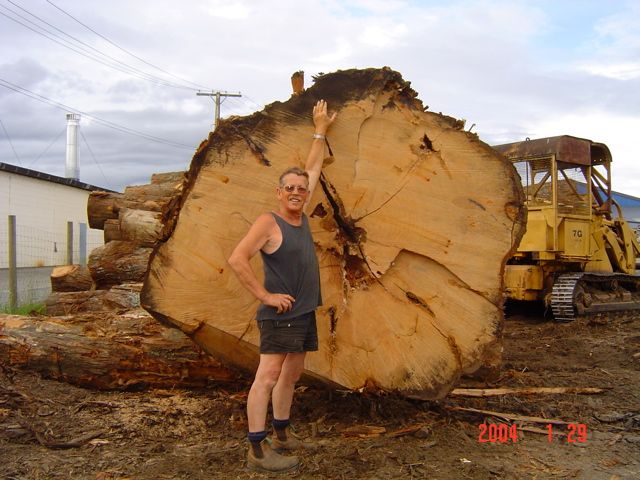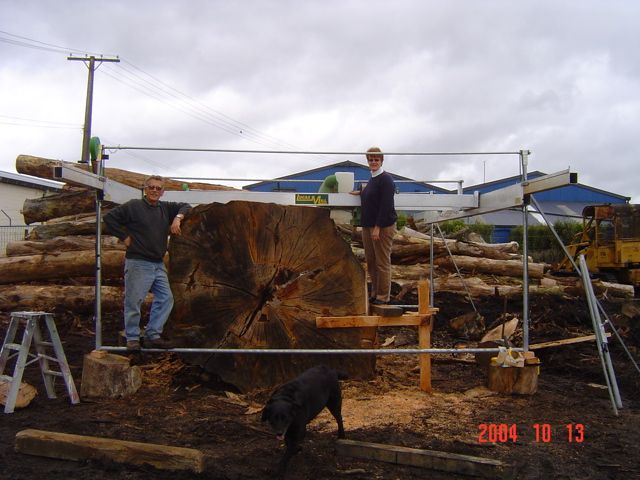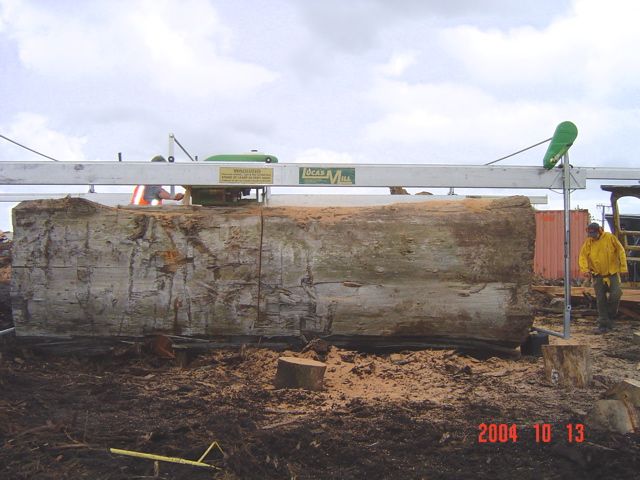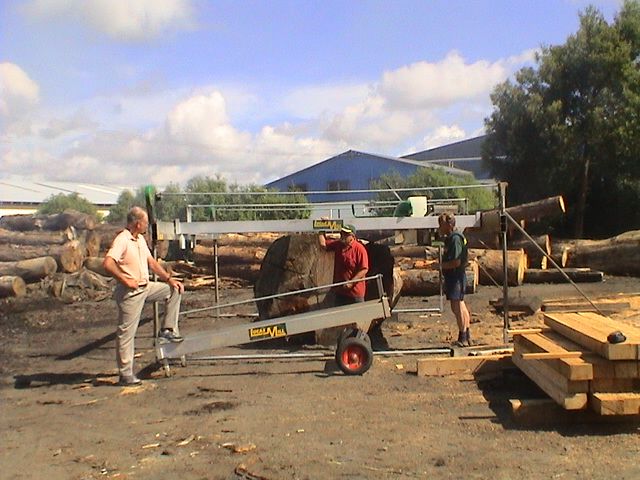Swing-Blade Mills Versus Bandsaw Mills
An extended discussion of the capabilities of both portable sawmill types, and some info on how to extend the swing-blade mill to handle super-sized logs. June 27, 2006
Question
I have found a used Lucas mill in Alaska. I think it is about 6 years old, but it has only been used a few times. I'm considering cutting some lumber with it. I don't have any operating information with it. I have sent off for the video. Any pros and cons on the mill? It looks like it would be most effective on larger logs. How does it work on smaller logs?
Forum Responses
(Sawing and Drying Forum)
From contributor A:
I personally have not found a good reason to ever use a Lucas mill. If you want 2x4's and 2x6's, it's fast. But if you have expensive logs and want to saw furniture wood, bandsaw is the only way to go. I do a lot of 28 inch wide boards for table tops and that is not possible to do with the Lucas mill. Plus, live sawing logs for speed can't be done with the Lucas. They then can be stickered and dried to be book matched when making tables and doors. I don't seem to have any problems cutting 72" diameter logs. Quarter saw them with my 3120 Husky chainsaw and move them onto my mill with the forklift, and cut them up. I also do have a video of the Lucas - really cool, but what a waste of wood to sawdust.
From contributor R:
If you have access to a Lucas, I'd go for it. You may want a cradle of sorts to hold multiple logs inside the frame and a dog or two to hold them to the cradle.
From contributor B:
"A waste of wood to sawdust"? That is a bit harsh. Swing blades are engineered to cut the most commonly used dimensions. There are advantages that can be stacked up on both sides. I've got two blades (not including the planer head) instead of 40, and I sharpen them myself. Give me a circular blade any day. Band saws don't cut wide; chainsaw mills cut wide, any width.
From contributor J:
If it's in good shape, buy it. Look for tweaked rails in case it was abused. I run a Lucas 825. Been making lumber for about 5 years with it. As for speed, my son and myself can get average 600-750 bf/hr. You want slabs? Get the slabbing attachment. You want shiplap siding? Get the attachment. You want to surface your slabs? Get the surfacing attachment.
As for cutting smaller logs, stack them on the blocks side by side and start cutting. I cut a lot of urban lumber - city trees, lots of Monterey pine, with big knots. My friend has a Wood-Mizer and the knots always create a challenge to keep the saw from cutting wavy lumber. Not a problem with a blade mill. I get my blades retipped and hammered for $30/blade. Service with Baileys is really good. And the parts are readily available.
Double check for tweaked rails and bent frame pieces in case they dropped it off a truck or hit it with a tractor. Run the motor, look for leaks and smoke. Check the belts. You should be able to pick it up at a discounted price. If not, buy a new one and get the warranty, etc.
The Lucas mill sure beats having to lift logs and turn cants and then lift the boards and stack them to edge them. It does it all in two passes. Go get it.
From contributor E:
I have a band mill and would take a swing blade any day. Not to replace the band mill, but because of its added versatility. I would like it for cutting dimension lumber and timbers, the ability to add a slabber, and the ability to use a surfacing blade. I also have a 5 foot bar and an 084, but it would be nice to be able to saw up the occasional monster log without quartering it. Or you could saw one up out of someone's backyard, for example, that would otherwise be cut into firewood because you can't get the equipment in there to retrieve the log.
Also, not everyone can justify or afford a forklift or large tractor to move logs around. Let alone a $2000.00 chainsaw for quartering.
From contributor S:
I just bought a Lucas and consider it one of the best "bangs for the buck" going. They are simple machines, cut true lumber and don't have the blade hassle of band mills. I bought it as an entry level machine and because of the log size limits of band mills.
What a Lucas and other swing mills will do better than bandmills is cut big logs without having to first cut them smaller! The only other common choice for big logs are dimension mills, which cost at least twice as much. I've got five 45+" logs right now and don't know of any band mill that I could afford that can cut them. A 16' foot log can weigh 10,000# and the hydraulics on a band mill, with a few exceptions, won't lift them onto the mill even if they could cut them. I don't have to have any equipment to move such logs.
On small logs, not so good because of moving the logs around. In my opinion, small conifers should be sold to a stud mill unless you need the wood for personal use. Stud mills are a lot more efficient at cutting small logs than any portable in a small 1 or 2 person operation ever will be.
I already want a band mill to go with the Lucas, but the basic reasons of getting it have not changed - large logs, low initial price, simple to operate and maintain and good dealer support on the west coast.
From contributor P:
I have both an Oscar 18 and a Lucas 613. Each has its use and advantages/disadvantages. I got the Lucas for the big stuff, and I have access to a good supply. Not veneer quality and they are shorts (under 12ft), but I'm only sawing for myself right now anyway. I got the small bandmill for the smaller and longer stuff. I also have the slabbing attachment for the Lucas, but haven't used it yet. Kind of a pain to swap it out, but it came with the mill when I bought it.
From contributor I:
I run a Peterson swing blade, very similar machine. What the guys say is right, they really come into their own with big logs in remote spots. I have hauled my mill into the middle of nowhere behind a quad bike and sawn up a 4' diameter cypress log, then dragged the boards and mill back out again. (Okay, it took a few trips.)
Smaller logs you can saw perfectly well, but you won't get the production figures that you will on the big logs. But that's true on any mill. Just give a bit of thought to the log handling, log support bunks and some sort of dogging system. Something like the Gripperdogs over on the sponsor's list makes small log sawing a lot easier. Also remember that everything about the mill is manual - it's not hard work and no great effort is needed to run the mill, but logs and boards are heavy. A day's milling is a real workout.
From the original questioner:
Thanks for all the thoughts on the mill. One thing this mill has going for it is that is already in Alaska, and freight is a killer. I like the fact that is very mobile - it will fit in a river boat or a landing craft. I think a lot of the birch would be in the 8" to 12" range. So I was interested in the Gripper Dogs. Has anyone used them? There are a few bigger spruce here - the biggest I have felled was 50", so maybe I'd find a few bigger logs to cut. Any thoughts on drying birch or birch lumber in general?
From contributor A:
Like I said, I have the video of the Lucas, and it is impressive. In fact, one of my sawmill buddies has a very large swing blade mill. It has a 60+ hp diesel engine on it. Many times larger than the Lucas. It make fantastic 2x boards.
I do own and operate the largest portable sawmill company in WA state. I have two of Cooks' mills. I have information on more than 25 different types of mills. I did my homework before I bought anything. In the summer of 2005 I did band blade tests for four blade manufacturers. I sharpen and set my own blades. I can only remember 2 times in five years and more than 1,000,000 bf that the blade made bad cuts. I don't have problems with this.
Someone made a comment of the forklift. I'm only 44 years old, my back works well and I would like to keep it that way. When I do a portable job, I take the forklift with me. It is as important as the mill.
I may have more than $75,000 in equipment, and the electric mill and gas powered are just the start. I have a 26,000 lb flatbed truck that the 35' sawmill frame is hauled on, plus the trailer that the forklift and mill head are on. The whole rig weighs 35,000 lbs. I started off years ago with all the logs all over the place, when I went to do a portable job. The forklift saves so much time.
I do have an engineering background, and lots of mods that I have done, the factory now does on their new mills. The big Husky saw I have only cost, at current price, $1,300.00 from Baileys, and you still need to buy the bar. I only paid $600.00 for it 6 years ago.
If you want the mill and it is in good shape, buy it. You are so right - shipping is really expensive to Alaska.
From contributor M:
I have a Lucas 618. I admit that it does not make wide lumber without some effort, but it really does shine with large logs. On smaller stuff, I would prefer a band mill. I don't really like cutting 12" or smaller logs, but if I do, I set up multiple logs and it really isn't too bad.
I think that it is easier for a beginner to make quality lumber with a circle blade mill, such as a swing blade, than with a band mill. You don't have to roll the log, there is less concern with waves, etc. However, my band mill experience is very limited and most of the folks that I know with band mills make great lumber, but they have plenty of experience as their teacher.
From contributor O:
I have used swing blades in New Zealand for some 10 years and deal with logs up to 12 feet in diameter. I don't have to 1/4 them and then lose the chain kerf plus have to true up the chain cuts and lose another 1/2 inch of wood. That must be added to the "very little dust" from a band mill. I also don't have to be an expert to sharpen and set bands. I am the first to say that band has a place in resaw work, but that is where it stops.
From contributor S:
12'! That's a big log. What kind of wood? What kind/model of swing mill? How do you do that? And just when I thought 8' was big!
From contributor O:
I run a Lucas 827 and have an extended wide trolley frame and the engine is taken out of the standard frame and put in when required. The bottom and top pipes on both end frames are also longer. I am the Lucas agent in New Zealand and am not afraid to explore the limits. The log I recently milled was 11 feet in diameter and weighed 16 tons on the crane. We have a lot of eucalyptus, macrocarpa, and radiata pine in big sizes. We also have native trees in New Zealand of which Rimu, Matai, Kauri and Kahikatea are large and very pretty timber.

Click here for full size image

Click here for full size image

Click here for full size image

Click here for full size image
From contributor G:
The way I see the band blade vs. swing mill controversy (if some see it as a controversy) is each type of mill has its solid place in the portable sawmill industry. If you are looking for any sort of production outside of the homeowner wanting his own lumber, a band blade mill should have hydraulics. Problem is a band blade mill with hydraulics can be expensive.
This is where the beauty of a swing mill comes in... the cost! You can do any type of milling with a swing mill, and even slabbing, but real wide slabs do take more time. I own and manufacture GripperDog Log Dogs and one of the main reasons I designed them was to make it easy for swing mill operators to be able to mill small logs. This, in my opinion, makes the swing blade mills more complete machines. We are a very small company, and have had great response and support from swing blade mill owners that have used GripperDogs.
From contributor M:
Contributor O, are the wide carriages available in the US? I sometimes have opportunity to cut larger logs (in excess of 6ft diameter). Is the engine swap difficult?
From contributor O:
Send an enquiry to Lucas. Tell them about mine in New Zealand and they may be able to put one together and ship to Baileys. Mark attention Rex Lucas. The engine swap takes about 5 minutes - you remove the sideshift, lift engine frame and reinstall sideshift and you're done, easy as that.



